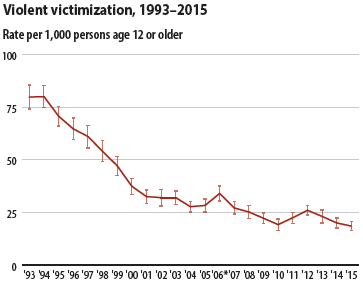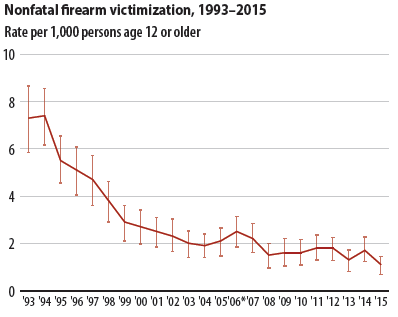Did Nonfatal Violent Crime Come Down Last Year After All?
Dueling crime statistics


Today the Bureau of Justice Statistics released a report on crimes committed in 2015. You will be happy to hear that both violent crime and property crimes declined.
You may also be confused to hear that, since it's been less than a month since the FBI released its report on crimes committed in 2015. That also showed property crimes declining, but violent crime went up 3.1 percent and homicides leaped 10.8 percent. What, you might ask, is going on here?
The answer is that it's hard to get solid crime numbers, so several competing means of measurement have evolved—none of them perfect, but each of them complementing the other. The FBI's statistics came from the Uniform Crime Reporting (UCR) program, which gathers offenses that have come to the attention of the police. This month's figures come from the National Crime Victimization Survey (NCVS), which gets its data by polling people; the idea is to tally offenses whether or not they've been reported to the police.
There are other differences between the two measurements. Most notably, the NCVS does not cover homicides. (Sorry, but you're stuck with that 10.8 percent jump.) Murder is the one crime where there's not a ton of doubt about the UCR numbers: People are much more likely to report a murder than a robbery; and bodies, as the saying goes, are hard to hide. It's certainly possible to get a homicide count wrong, as Chicagoans recently learned, but the UCR figures are the best we've got, and in any event you can't exactly survey the dead about how they died.
There are other crimes that are included in the UCR but not the NCVS (such as offenses against children under 12), and there are crimes that are covered by the NCVS but not the UCR (such as simple assault). But the biggest difference is the NCVS's attempt to include crimes that weren't reported to the police. And that's one reason it's good news that it didn't show a spike last year.

One of the biggest questions about last month's UCR numbers is why homicides rose so much more than violent crime in general. Several people—including me—speculated that nonfatal violent crimes may have surged more sharply than the FBI report suggested; they just didn't show up in the police figures because they weren't reported as consistently as the homicides were. The new NCVS is a reassuring sign that those speculations might not be true.
Of course, the NCVS has its limits too. The people its pollsters have the hardest time reaching are low-income minorities without a fixed address—precisely the people who are most likely to be the victims of violent crimes. In a 2014 piece for ProPublica, Lois Beckett pointed out that yet another source of crime data, the Centers for Disease Control's count of nonfatal but violent gun injuries, had been going up over the previous decade even as the NCVS showed such assaults declining. So which was right? On one hand, she noted, the CDC's tabulations may be more likely to include the victims that the NCVS was unable to reach. On the other hand, the CDC figures "are based on a representative sample of 63 hospitals nationwide, and the margin of error for each estimate is very large."
Whatever its limitations, the NCVS gives us a more complete picture of crime in America—and this year, it cuts against some of the sky-is-falling rhetoric that's been sloshing around ever since the UCR numbers were published. Here are some highlights from the report:
• The overall rate of violent crime declined slightly from 2014 to 2015, falling from 20.1 victimizations per 1,000 people to 18.6 per 1,000.
• Property crime also dipped, dropping from 118.1 per 1,000 households to 110.7 per 1,000.
• Most specific categories of crime logged a decline, though not always a statistically significant one. Robbery, aggravated assault, simple assault, burglary, theft, serious violent crime involving weapons, and serious violent crime involving injury all came down. But sexual assault, serious domestic violence, and serious intimate partner violence all saw slight increases, as did motor vehicle theft.
To read the full study, which includes a more detailed discussion of the differences between the NCVS and UCR, go here.


Show Comments (9)